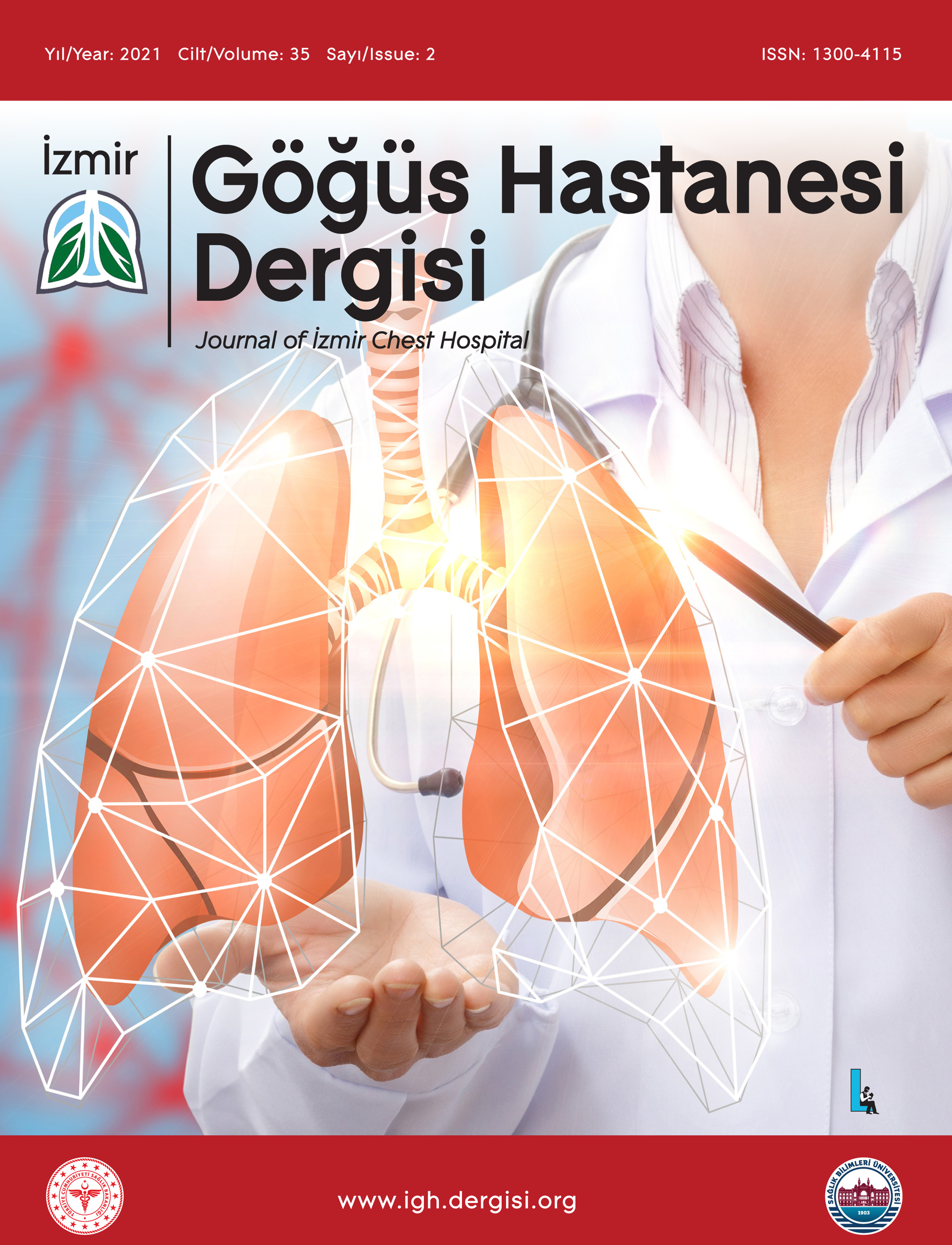Malign Plevral Sıvılarda Plevral Sıvı ve Serum Nötrofil-Lenfosit Oranının Prognostik Etkisi
Filiz Güldaval1, Ceyda Anar2, Mine Gayaf1, Gulru Polat1, Merve Ayık Türk4, Melike Yüksel Yavuz3, Aysu Ayrancı3, Gülistan Karadeniz1, Melih Büyükşirin1, Fatma Demirci Üçsular11Sağlık Bilimleri Üniversitesi Doktor Suat Seren Göğüs Hastalıkları ve Cerrahisi Eğitim Araştırma Hastanesi, Göğüs Hastalıkları Ana Bilim Dalı, İzmir, Türkiye2İzmir Katip Çelebi Üniversitesi Atatürk Eğitim ve Araştırma Hastanesi, Göğüs Hastalıkları Ana Bilim Dalı, İzmir, Türkiye
3İzmir Bakırçay Üniversitesi Çiğli Eğitim Araştırma Hastanesi, Göğüs Hastalıkları Ana Bilim Dalı, İzmir, Türkiye
4Sağlık Bilimleri Üniversitesi İzmir Bozyaka Eğitim Araştırma Hastanesi, Göğüs Hastalıkları Ana Bilim Dalı, İzmir, Türkiye
GİRİŞ ve AMAÇ: Çeşitli araştırmalarda serum nötrofil-lenfosit oranının (sNLR) çeşitli kanser tiplerine sahip hastalarda uygun maliyetli ve yararlı bir prognostik faktör olarak kullanılabileceği bildirilmiştir. Malign plevral efüzyonda (MPE) NLR'nin prognoz üzerindeki klinik etkisini araştırdık.
YÖNTEM ve GEREÇLER: MPE tanısı alan tüm hastalar retrospektif olarak incelendi. sNLR ve malign plevra sıvısı NLR (mNLR) değeri, yaş, Eastern Cooperative Oncology Group (ECOG), histopatolojik tip, serum albümin ve laktat dehidrogenaz (LDH) ile sağkalım arasındaki ilişki araştırıldı.
BULGULAR: Çalışmaya toplam 222 hasta dahil edildi ve ortalama yaş 65,7 ± 11,5 idi. mNLR değeri ≥0,42 ve sNLR değeri ≥4,75 olan hastalarda sağkalımın daha kısa olduğu saptandı (p: 0,001). Çok değişkenli analizde mNLR değeri 0,42 ve / veya sNLR değeri ≥4,75 (Odds oranı (OR): 2,66, p: 0,001), serum LDH> 210 (OR = 1,8, p: 0,001) ve yaş> 65 (OR = 1.9, P = 0,001) olmasının sağkalımla ilişkili olduğu görüldü.
TARTIŞMA ve SONUÇ: sNLR ve mNLR, MPE'li hastalarda basit, kullanışlı ve uygun maliyetli bir prognostik faktör olarak kullanılabilir. Ayrıca, bu sonuçlar gelecekte mNLR ile ilgili daha fazla araştırmanın temel taşı olarak hizmet edebilir. Sonuçlarımızı genelleştirmek için daha fazla çalışmaya ihtiyaç duyulmasına rağmen, bu bilgiler MPE'li hastalar için en uygun tedaviyi belirlemede klinisyenlere ve hastalara fayda sağlayacaktır.
Prognostic Effects of Neutrophil-Lymphocyte Rates in Serum and Pleural Fluids in Malignant Pleural Fluids
Filiz Güldaval1, Ceyda Anar2, Mine Gayaf1, Gulru Polat1, Merve Ayık Türk4, Melike Yüksel Yavuz3, Aysu Ayrancı3, Gülistan Karadeniz1, Melih Büyükşirin1, Fatma Demirci Üçsular11Department of Pulmonology, Health Siences University Doctor Suat Seren Chest Diseases and Surgery Training and Research Hospital, İzmir, Turkey2Department of Pulmonology, Katip Çelebi University Atatürk Training and Research Hospital, İzmir, Turkey
3Department of Pulmonology, Bakırçay University Çiğli Training and Research Hospital, İzmir, Turkey
4Department of Pulmonology, Health Siences University İzmir Bozyaka Training and Research Hospital, İzmir, Turkey
Backgrounds: Various studies have reported that the neutrophil-to-lymphocyte ratio in the serum (sNLR) may serve as a cost-effective and useful prognostic factor in patients with various cancer types. We investigated the clinical impact of NLR as a prognostic factor in malign pleural effusion (MPE) and sNLR on prognosis in MPE.
Methods: We retrospectively reviewed all of the patients who were diagnosed MPE. The relationship between sNLR and neutrophil-to-lymphocyte ratio in the malign pleural effusion (mNLR) value, age, Eastern Cooperative Oncology Group (ECOG), histopathologic type, serum albumin and lactate dehydrogenase (LDH) with survival were investigated.
Results: A total of 222 patients with a mean age of 65.7±11.5 were included in the study. Patients with a mNLR value ≥0.42 and a serum NLR value ≥4.75 had a shorter survival (p: 0.000). Multivariate analysis, which showed that survival was significantly related mNLR value > 0.42 and/or sNLR value > 4.75 (Odds Ratio (OR): 2.66, %95 CI, 1,65-4,3 p: 0.001), serum LDH > 210 (OR = 1.8, %95 CI, 1,33-2,46 p: 0.001) and age > 65 (OR = 1.9, %95 CI, 1,41-2,55 p = 0.001).
Conclusions: sNLR and mNLR may act as a simple, useful, and cost-effective prognostic factor in patients with MPE. Furthermore, these results may serve as the cornerstone of further research into the mNLR in the future. Although further studies are required to generalize our results, this information will benefit clinicians and patients in determining the most appropriate therapy for patients with MPE.
Makale Dili: İngilizce






